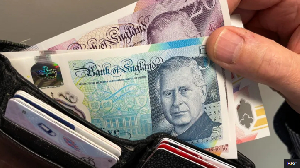 The portrait is the only change to existing banknotes
The portrait is the only change to existing banknotes
New banknotes featuring the portrait of King Charles III have now entered circulation, but it may be some time before they are commonly seen in wallets and purses.
The new Bank of England notes will gradually replace those which are damaged, or will be issued when demand increases.
The King is only the second monarch to appear on these notes, with Queen Elizabeth II first featuring in 1960.
Shoppers can still use current circulating £5, £10, £20 and £50 notes carrying the portrait of the late Queen.
The reverse side of current polymer Bank of England banknotes, which in ascending order feature Sir Winston Churchill, Jane Austen, JMW Turner and Alan Turing, are unchanged. Notes issued in Scotland and Northern Ireland feature other images, and not the monarch.
The first new banknotes were printed last year, with the long lead-in time allowing automated machines that accept cash to be updated to recognise the new designs. The King's portrait is based on a picture taken in 2013.
In April last year, the BBC was given exclusive access to the highly-secure site where the notes are being produced.
A year on, the King was presented with a full set with the lowest serial numbers, following the tradition of the monarch receiving the first issues of new banknotes.
Collectors seek banknotes which come as close to the 00001 serial number as possible.
While the King is appearing on banknotes, cash may be disappearing from our lives.
"This is a historic moment, as it’s the first time we’ve changed the sovereign on our notes," said Bank of England governor, Andrew Bailey.
"We know that cash is important for many people, and we are committed to providing banknotes for as long as the public demand them."
But a survey for Link, the UK’s cash access and ATM network, found that nearly half (48%) of those asked said they expected a cashless society during their lifetime.
However, the same proportion said this would be problematic, and 71% of those surveyed said they still had some level of everyday reliance on cash.
Yet figures from consumer association Which? found that 6,000 bank branches had closed in the last nine years, leaving many places with none at all and limited access to cash.